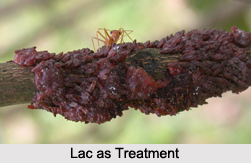 Lac insect scientifically named as Coccus lacca, has been known to the Hindus from a very ancient period. The Butea frondosa is called Laksha taru or lac plant in Sanskrit, this being the principal tree in which lac is said to be produced.
Lac insect scientifically named as Coccus lacca, has been known to the Hindus from a very ancient period. The Butea frondosa is called Laksha taru or lac plant in Sanskrit, this being the principal tree in which lac is said to be produced.
Various Uses of Lac
The fluid lac-dye obtained by dissolving the crushed stick-lac in water is called Alakta. It is used in colouring silk. Cotton coloured with this dye and pressed into flat circular pieces is sold in the bazars under the name of "Alta" and is used in painting the hands and feet of Hindu females. Shellac is used in the preparation of sealing wax, varnish for carpenters and ornaments for women.
Dose of Lac in Medicine
Shellac, finely powdered, half-a-tola mixed with honey and prepared in the form of an electuary is given in Haematemesis. A decoction of shellac is much used in the preparation of several medicinal oils, such as Lakshadi Taila, Chandanadi Taila, Angaraka Taila, etc.
Lakshadi Taila: Take shellac 2 seers, water 16 seers, boil till reduced to 4 seers and strain. To this decoction of shellac add 4 seers of prepared sesamum oil, 16 seers of whey and 2 tolas each of the following substances, namely, Withania somnifera (asvagandha), turmeric, devadaru wood, root of Sanseviera Zeylanica (murva), Pandanus odoratissimus (Ketaki), Vanda Roxburghii (rasna), dill seeds and liquorice root in the form of a paste and prepare an oil in the usual way; lastly add 4 tolas of camphor. This oil is much used for inunction in chronic fever and consumption. The other oils containing lac are prepared in a similar way, with the addition of various medicinal substances in the form of paste.
This article is a stub. You can enrich by adding more information to it. Send your Write Up to content@indianetzone.com





